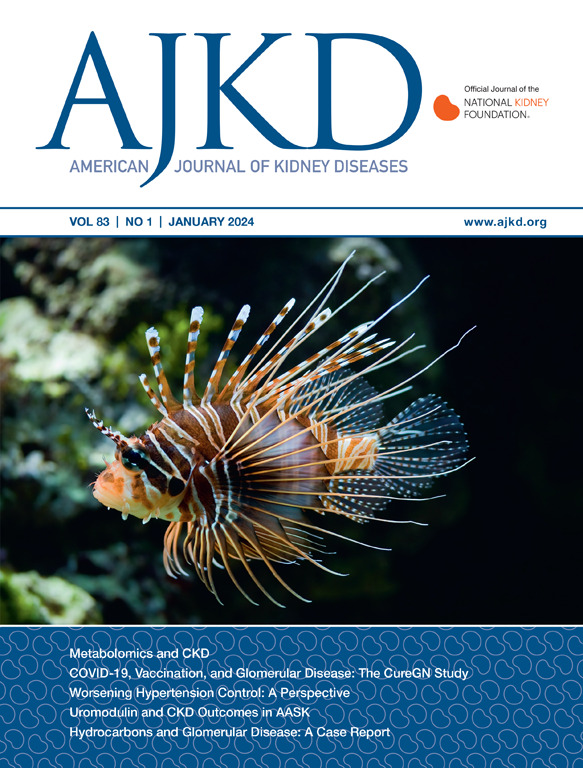Highlights from the January 2024 Issue
SPECIAL ANNOUNCEMENT:
This entire issue will be freely available until December 31, 2024
Editor’s Note: We asked authors of Original Investigations to provide short plain-language summaries that would briefly summarize what inspired their study, the basic approach taken, what was learned, and why it matters. We hope our readers will find this valuable in helping them keep up with the latest research in the field of nephrology. Highlights from the January 2024 issue:
Nuclear Magnetic Resonance–Based Metabolomics and Risk of CKD by Ting-Ting Geng et al
From the authors: The relationship between individual lipoprotein particle subclasses and lipid-related traits and risk of chronic kidney disease (CKD) in general population is unclear. Using data from 91,532 participants in the UK Biobank, we evaluated the associations of metabolites measured using nuclear magnetic resonance testing with the risk of CKD. We identified that 90 out of 142 lipid biomarkers were significantly associated with incident CKD. We found that very-low-density lipoproteins, high-density lipoproteins, the lipid concentration and composition within these lipoproteins, triglycerides within all the lipoprotein subclasses, fatty acids, amino acids, and inflammation biomarkers were associated with CKD risk. These findings advance our knowledge about mechanistic pathways that may contribute to the development of CKD.
DOI: 10.1053/j.ajkd.2023.05.014
EDITORIAL: A Deeper Dive Into Lipid Alterations in CKD by Denise C. Hasson et al [FREE]
Use of Analog and Human Insulin in a European Hemodialysis Cohort With Type 2 Diabetes: Associations With Mortality, Hospitalization, MACE, and Hypoglycemia by Thomas Ebert et al (OPEN ACCESS)
From the authors: People with diabetes who are receiving dialysis for kidney failure are at high risk of cardiovascular disease and death. This study uses information from 1,446 people with kidney failure from 7 European countries who are receiving dialysis, have type 2 diabetes, and are prescribed either insulin identical to that made in the body (human insulin) or insulins with engineered extra features (insulin analog). After 3 years, fewer participants receiving analog insulins had died, had been admitted to the hospital, or had a cardiovascular event (heart attack, stroke, heart failure, or peripheral vascular disease). These findings suggest that analog insulins should be further explored as a treatment leading to better outcomes for people with diabetes on dialysis.
DOI: 10.1053/j.ajkd.2023.05.010
EDITORIAL: Insulin Management in Patients With Diabetes Receiving Hemodialysis: Unanswered Questions and Way Forward by Rozalina G. McCoy et al [FREE]
Using Relative Survival to Estimate the Burden of Kidney Failure by Margaret R. Stedman et al
From the authors: Estimates of death due to kidney failure can be misleading because death information from kidney failure is intertwined with death due to aging and other chronic diseases. Life tables are an old method, commonly used by actuaries and demographers to describe the life expectancy of a population. We developed life tables specific to a patient’s age, sex, year, race, and comorbidity. Survival is derived from the life tables as the percentage of patients who are still alive in a specified period. By comparing survival of patients with kidney failure to the survival of people from the general population, we estimate that patients with kidney failure have one-third the chance of survival in 5 years compared with people with similar demographics and comorbidity but without kidney failure. The importance of this measure is that it provides a quantifiable estimate of the immense mortality burden of kidney failure.
DOI: 10.1053/j.ajkd.2023.05.015
Association of COVID-19 Versus COVID-19 Vaccination With Kidney Function and Disease Activity in Primary Glomerular Disease: A Report of the Cure Glomerulonephropathy Study by Chia-shi Wang et al
From the authors: In this cohort study of 2,055 patients with minimal change disease, focal segmental glomerulosclerosis, membranous nephropathy, or IgA nephropathy, COVID-19 resulted in hospitalization or death for 1 in 8 cases and was associated with a 35% increase in risk for worsening proteinuria. By contrast, vaccination did not appear to adversely affect kidney function or proteinuria. Our data support vaccination for COVID-19 in patients with glomerular disease.
DOI: 10.1053/j.ajkd.2023.07.008
Outcomes of Integrated Home Dialysis Care: Results From the Canadian Organ Replacement Register by Louis-Charles Desbiens et al
From the authors: The integrated home dialysis model proposes the initiation of dialysis with peritoneal dialysis (PD) and subsequent transition to home hemodialysis (HHD) once PD is no longer feasible. It allows patients to benefit from initial lifestyle advantages of PD and to continue home-based treatments after its termination. However, some patients may prefer to initiate dialysis with HHD from the outset. In this study, we compared the long-term clinical outcomes of both approaches using a large Canadian dialysis register. We found that both options led to a similar risk of hospitalization. In contrast, the PD-to-HHD model led to improved survival when controlling for the duration of kidney failure.
DOI: 10.1053/j.ajkd.2023.05.011
Comparative Effectiveness of Alternative Treatment Approaches to Secondary Hyperparathyroidism in Patients Receiving Maintenance Hemodialysis: An Observational Trial Emulation by Alyssa Platt et al
From the authors: Optimal approaches to treat secondary hyperparathyroidism (SHPT) have not been established in randomized controlled trials. Data from a national dialysis organization was used to identify patients with SHPT in whom escalated treatment may be indicated. The approach to treatment was defined based on observed upward titration of SHPT-controlling medications: earlier titration (lower target) versus delayed titration (higher target); and the choice of medication (cinacalcet vs vitamin D sterols). In the first trial emulation, we estimated a 29% lower rate of death and 26% lower rate of cardiovascular disease or death for patients managed with a lower versus higher target approach. Cinacalcet versus vitamin D-favoring approaches were not consistently associated with outcomes in the second trial emulation. This observational study suggests the need for additional clinical trials of SHPT treatment intensity.
DOI: 10.1053/j.ajkd.2023.05.016
Associations of Baseline and Longitudinal Serum Uromodulin With Kidney Failure and Mortality: Results From the African American Study of Kidney Disease and Hypertension (AASK) Trial by Teresa K. Chen et al (OPEN ACCESS)
From the authors: Prior studies of uromodulin (UMOD), the most abundant protein in urine, and kidney disease have focused primarily on urinary UMOD levels. The present study evaluated associations of serum UMOD levels with the risks of kidney failure with replacement therapy (KFRT) and mortality in a cohort of African American adults with hypertension and chronic kidney disease. It found that participants with lower levels of UMOD at baseline were more likely to experience KFRT even after accounting for baseline kidney measures. Similarly, participants who experienced steeper annual declines in UMOD also had a heightened risk of kidney failure. Neither baseline nor annual change in UMOD was associated with mortality. Serum UMOD is a promising biomarker of kidney health.
DOI: 10.1053/j.ajkd.2023.05.017
The Association of Class I and II Human Leukocyte Antigen Serotypes With End-Stage Kidney Disease Due to Membranoproliferative Glomerulonephritis and Dense Deposit Disease by Halimat Afolabi et al
From the authors: Prior studies have suggested dysregulation of the alternative complement pathway as a potential etiology of membranoproliferative glomerulonephritis (MPGN), but recent evidence from a British White population has implicated an autoimmune mechanism in MPGN pathogenesis. We investigated HLA associations between MPGN and dense deposit disease (DDD) in a large racially and ethnically diverse cohort of patients. We found that HLA-DR17 is associated with end-stage kidney disease (ESKD) due to MPGN in both White and Black patients. By contrast, no significant HLA associations with ESKD due to DDD were identified. These results suggest a role for autoimmunity in some cases of MPGN and highlight differences in the disease etiology of MPGN compared with DDD.
DOI: 10.1053/j.ajkd.2023.06.005
Perspective from the January 2024 issue:
Lost in Translation: Why Are Rates of Hypertension Control Getting Worse Over Time? by Dena Rifkin
Treatment of hypertension to decrease rates of cardiovascular disease is the most well studied and most broadly applicable treatment in cardiovascular prevention. Blood pressure can be measured anywhere, not just in a physician’s office; medications are readily available, inexpensive, and have highly favorable benefit/harm ratios with relatively minimal side effects; and stepped medication regimens can be prescribed in algorithmic fashion by a variety of practitioners. Yet overall hypertension control rates in the United States have never exceeded 60%, and the last 5-10 years have seen decreased, rather than increased, rates of control. Here, I describe the scale of this massive failure to deliver on the promise of preventive hypertension care; outline the populations most affected and the contemporaneous events that have impacted hypertension control; discuss the disparate paths of hypertension science and health care delivery; and highlight novel interventions, approaches, and future opportunities to bend the curve back toward improvements in hypertension control.
DOI: 10.1053/j.ajkd.2023.06.004
 On the Cover: Uromodulin is a urinary protein produced in human kidney tubules. It is also found in the skin of amphibians and in the gills of fish, including the lionfish pictured on the cover. The appearance of uromodulin in such diverse tissues suggests it may have served a waterproofing role for the early vertebrates and that it plays a related role in humans by regulating the transport of salt and water. In this month’s issue of AJKD, the Original Investigation by Chen et al demonstrates yet another role for this versatile protein as a novel biomarker for kidney disease.
On the Cover: Uromodulin is a urinary protein produced in human kidney tubules. It is also found in the skin of amphibians and in the gills of fish, including the lionfish pictured on the cover. The appearance of uromodulin in such diverse tissues suggests it may have served a waterproofing role for the early vertebrates and that it plays a related role in humans by regulating the transport of salt and water. In this month’s issue of AJKD, the Original Investigation by Chen et al demonstrates yet another role for this versatile protein as a novel biomarker for kidney disease.
“The photograph “MC Rotfeuerfisch” by Christian Mehlführer is released on Wikimedia Commons under the CC-BY-2.5 license.
Special thanks to Editorial Intern Rachel Shulman for curating the cover image and drafting the cover blurb for this issue.
The editors are delighted to recognize these articles that have been selected to receive the 2023 AJKD Editors’ Choice Award (all articles are freely available until March 1, 2024).




Leave a Reply